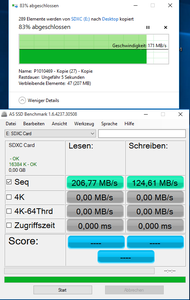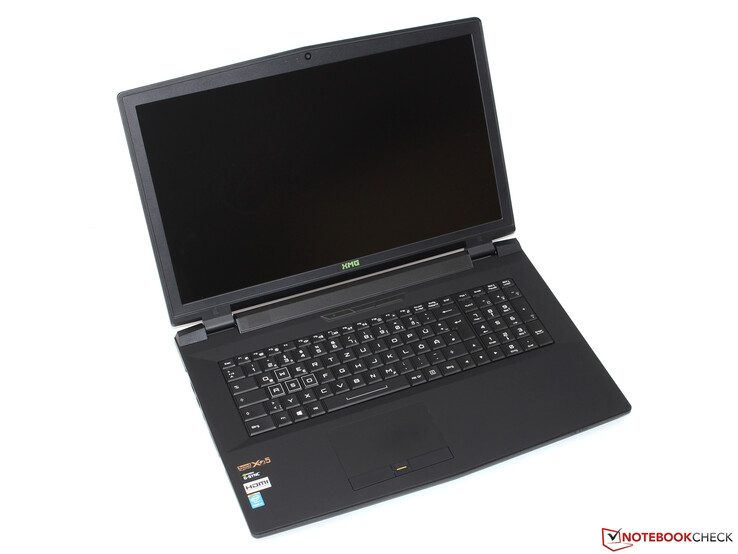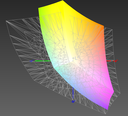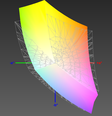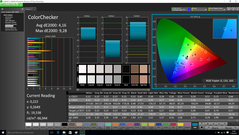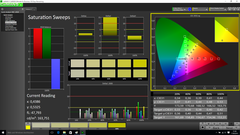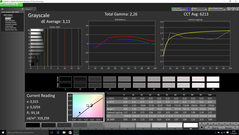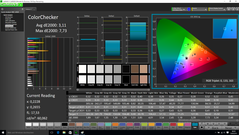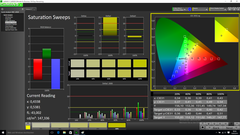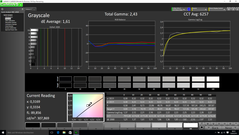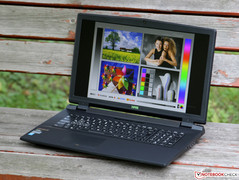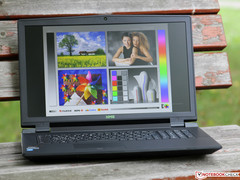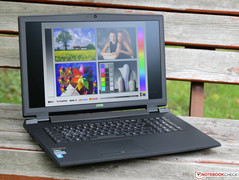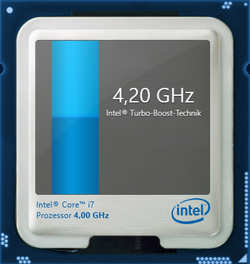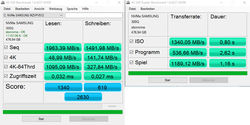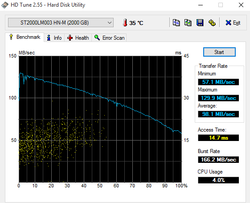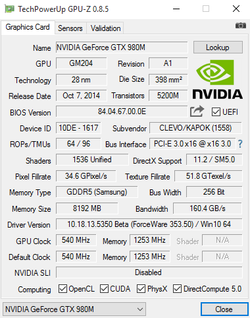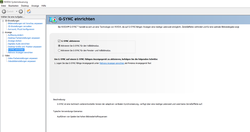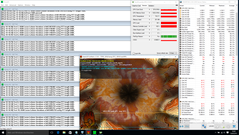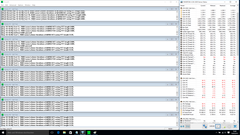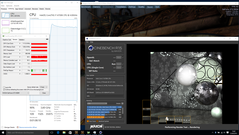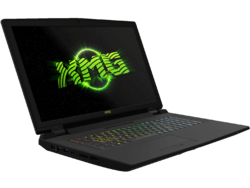Schenker XMG U706 (Clevo P771DM) Notebook Review

For the original German review, see here.
What can you do when even the swiftest of mobile processors do not deliver enough power? Easy - you install a normal desktop CPU in the laptop. Schenker proved that this idea not only functions in practice, but also has its appeal with its XMG U705 based on Clevo's P771ZM barebones introduced earlier this year. Now the manufacturer upgrades again: The modern Skylake platform replaces the former Haswell platform in the new XMG U706 (Clevo P771DM). Its 14 nanometer build promises higher performance and improved energy efficiency.
Compared with the also relatively pricey predecessor, Schenker has increased the price of the 17-inch machine noticeably. It now starts at 1849 Euros (~$2074), but already features a Core i5-6600, 8 GB of DDR4-2400 RAM, a matte IPS screen, and a fast GTX 970M in the base configuration. The CPU, storage, graphics card, Wi-Fi module and other components can be upgraded in the online configurator - for a price. Our generously configured review sample with a Core i7-6700K, 16 GB RAM, GeForce GTX 980M and two storage devices (512 GB SSD + 2 TB hard drive) plus operating system even cracks the 3000 Euro mark (~$3366) - an aspect that we will consider in the following comparison with rivals like Asus' G751JY, MSI's GT72 or Alienware's 17 R2.
Case – A Comparison with the Predecessor
The bulky, almost 4 kilogram (~8.8 lb) and 3.9 centimeters (~1.5 in) tall Clevo barebones does not look very different from its Haswell counterpart (see One K73-5N review) at first glance. Only the modern USB 3.1 / Thunderbolt 3 port (Type C port) on the casing's left is worth mentioning. However, the five USB 3.0 ports have been axed for that. Otherwise, nothing has changed, which is not at all meant as criticism. Highlights, such as two DisplayPort 1.2s, an HDMI 2.0 socket and optical S/PDIF interface are not found in every device even in this category.
All details concerning casing, the extensive maintenance options and input devices can be found in the review of the One K73-5N.
Display
While more and more laptops are being offered with a 4K display in the 15.6-inch sector, it seems as if corresponding 17.3-inch screens do not yet exist. Not only Schenker/Clevo, but also all competitors still exclusively install Full HD panels with 1920x1080 pixels. The desktop and pixel density (127 ppi) could be a bit larger for our taste, but we cannot reproof the manufacturer for this since there are no alternatives. However, all three video outs in the XMG U706 support 3840x2160 pixels at 60 Hz, which provides enough options for connecting high-definition, external monitors.
In terms of quality, the LP173WF4-SPD1 IPS screen from LG belongs to the best of its kind - not without reason do Asus and MSI use exactly the same model. The screen's maximum brightness of 287 cd/m² is more than bright enough for indoor use. The LED backlight also illuminates the entire image area very homogeneously, and hardly shows signs of clouding or backlight bleeding. The rich black reproduction leads to an outstanding contrast ratio of 977:1, which is at the upper limit of what can be expected from an IPS based display nowadays. The image still looks very rich and vivid even without a reflective glossy finish.
| |||||||||||||||||||||||||
Brightness Distribution: 91 %
Center on Battery: 298 cd/m²
Contrast: 977:1 (Black: 0.305 cd/m²)
ΔE ColorChecker Calman: 4.16 | ∀{0.5-29.43 Ø4.79}
ΔE Greyscale Calman: 3.13 | ∀{0.09-98 Ø5}
84.5% sRGB (Argyll 1.6.3 3D)
55.5% AdobeRGB 1998 (Argyll 1.6.3 3D)
61.9% AdobeRGB 1998 (Argyll 3D)
84.7% sRGB (Argyll 3D)
66.6% Display P3 (Argyll 3D)
Gamma: 2.26
CCT: 6213 K
| Schenker XMG U706 1.920 x 1.080 IPS-Panel | Asus G751JY 1.920 x 1.080 IPS-Panel | MSI GT72-2QE16SR21BW 1.920 x 1.080 IPS-Panel | Alienware 17 R2 1.920 x 1.080 IPS-Panel | |
|---|---|---|---|---|
| Display | -2% | 2% | 0% | |
| Display P3 Coverage (%) | 66.6 | 65.9 -1% | 68.1 2% | 66.6 0% |
| sRGB Coverage (%) | 84.7 | 83.1 -2% | 86.7 2% | 84.3 0% |
| AdobeRGB 1998 Coverage (%) | 61.9 | 60.8 -2% | 63.4 2% | 61.6 0% |
| Screen | -1% | -20% | -1% | |
| Brightness middle (cd/m²) | 298 | 329 10% | 285 -4% | 331 11% |
| Brightness (cd/m²) | 287 | 320 11% | 278 -3% | 307 7% |
| Brightness Distribution (%) | 91 | 92 1% | 87 -4% | 84 -8% |
| Black Level * (cd/m²) | 0.305 | 0.34 -11% | 0.45 -48% | 0.3 2% |
| Contrast (:1) | 977 | 968 -1% | 633 -35% | 1103 13% |
| Colorchecker dE 2000 * | 4.16 | 4.13 1% | 5.1 -23% | 4.88 -17% |
| Greyscale dE 2000 * | 3.13 | 3.72 -19% | 5.23 -67% | 3.63 -16% |
| Gamma | 2.26 97% | 2.36 93% | 2.32 95% | 2.17 101% |
| CCT | 6213 105% | 6352 102% | 7565 86% | 6325 103% |
| Color Space (Percent of AdobeRGB 1998) (%) | 55.5 | 55 -1% | 57 3% | 55 -1% |
| Color Space (Percent of sRGB) (%) | 84.5 | 83 -2% | 87 3% | 84.2 0% |
| Colorchecker dE 2000 max. * | 8.01 | |||
| Total Average (Program / Settings) | -2% /
-1% | -9% /
-14% | -1% /
-1% |
* ... smaller is better
As to color reproduction, the screen might not satisfy the need of professional photographers and image editors, but the extent of the color space (sRGB: 84.5 percent; AdobeRGB: 55.5 percent) and quality of factory calibration is very impressive for a consumer product. Thus, the DeltaE shifts range on a relatively low level ex-factory (grayscale: 3.1; colors: 4.2), and decrease even further with our optimized ICC profile (grayscale: 1.6; colors: 3.1).
Outdoors (overcast)
As typical for IPS, the image quality only worsens insignificantly from a slanted view. The representation only looks increasingly pale after the viewing angle goes beyond 45 degrees because the contrast ratio and color saturation gradually decrease. However, even several viewers can enjoy the content in everyday operation, for example a movie night with friends a few meters away from the laptop. That is often not the case with a simple TN screen.
Performance
Disregarding the exorbitantly expensive 6 and 8 core processors of the Haswell E platform, our review sample sports the presently strongest desktop processor on the market with the Core i7-6700K. With a base clock rate of 4.0 GHz (Turbo Boost: 4.2 GHz in single-thread mode), the Skylake-based quad-core even outperforms the swiftest laptop models by several hundred MHz. The price: Despite the modern 14 nanometer build, Intel specifies the chip with an enormous TDP of 91 watts. In addition to the i7-6700K, three other processors in the form of the i5-6600 (3.3-3.9 GHz), i5-6600K (3.5-3.9 GHz) and i7-6700 (3.4-4.0 GHz) can be selected in the online configurator. However, none of the latter support Hyperthreading (i7 line only) or have free multipliers for overclocking (K models only).
The buyer can opt for either a GeForce GTX 970M (6 GB GDDR5) or, as in our case, the GeForce GTX 980M (8 GB GDDR5) graphics solution. The latter costs a good 370 Euros (~$415) extra. The recently presented, even swifter GeForce GTX 980 - a virtually identical counterpart technically of the similarly named desktop model - is unfortunately not available for the XMG U706, probably because its even higher energy requirement would take its toll on the reserves of the power supply and cooling. Clevo's barebones does not support Nvidia's Optimus technology, i.e. dynamic switching to the processor graphics, either.
A total of four DDR4 slots theoretically allow installing a maximum of up to 64 GB of RAM - we were satisfied with 2x 8 GB of DDR4-2400 for this test. The option of installing different storage devices is also impressive: Two M.2 2280 slots (SATA or PCIe 3.0 x4) and two 2.5-inch slots (9.5 millimeters height) can be fitted with SSDs and/or HDDs, and be operated in pairs in RAID 0/1. One M.2 and one 2.5-inch slot remained empty in the present review sample.
Processor
The Core i7-6700K clocked stably at 4.0 GHz even after several runs of Cinebench R15 or other CPU benchmarks (the Turbo of up to 4.2 GHz is only sporadic and only active in single thread applications), and thus it achieved correspondingly high scores. On average, the desktop model has an edge of good 20 percent on a Core i7-5700HQ (Broadwell, 47 watts) or Core i7-6820HK (Skylake, 45 watts). The older i7-4710MQ (Haswell, 47 watts) is even surpassed by approximately 30 percent.
We deem the Core i5-6600K, which Schenker also offers, as only conditionally recommendable. It lags behind by up to 30 percent in multi-threaded software due to its lack of Hyperthreading. Buyers who want to save money should preferably take a Core i7. It is situated between the 6600K and 6700K, and promises to be considerably more future-proof than the i5 thanks to its 8 threads.
| Cinebench R15 | |
| CPU Single 64Bit (sort by value) | |
| Schenker XMG U706 | |
| Asus G751JY-T7009H | |
| MSI GT72-2QE16SR21BW | |
| Alienware 17 R2 | |
| Schenker XMG U506 | |
| Clevo P671RG | |
| Clevo P671RG (OC 4 GHz) | |
| CPU Multi 64Bit (sort by value) | |
| Schenker XMG U706 | |
| Asus G751JY-T7009H | |
| MSI GT72-2QE16SR21BW | |
| Alienware 17 R2 | |
| Schenker XMG U506 | |
| Clevo P671RG | |
| Clevo P671RG (OC 4 GHz) | |
| Cinebench R11.5 | |
| CPU Single 64Bit (sort by value) | |
| Schenker XMG U706 | |
| Asus G751JY-T7009H | |
| MSI GT72-2QE16SR21BW | |
| Alienware 17 R2 | |
| Schenker XMG U506 | |
| Clevo P671RG | |
| Clevo P671RG (OC 4 GHz) | |
| CPU Multi 64Bit (sort by value) | |
| Schenker XMG U706 | |
| Asus G751JY-T7009H | |
| MSI GT72-2QE16SR21BW | |
| Alienware 17 R2 | |
| Schenker XMG U506 | |
| Clevo P671RG | |
| Clevo P671RG (OC 4 GHz) | |
| X264 HD Benchmark 4.0 | |
| Pass 1 (sort by value) | |
| Schenker XMG U706 | |
| Asus G751JY-T7009H | |
| Clevo P671RG | |
| Clevo P671RG (OC 4 GHz) | |
| Pass 2 (sort by value) | |
| Schenker XMG U706 | |
| Asus G751JY-T7009H | |
| Clevo P671RG | |
| Clevo P671RG (OC 4 GHz) | |
| Geekbench 3 | |
| 64 Bit Single-Core Score (sort by value) | |
| Schenker XMG U706 | |
| Clevo P671RG | |
| Clevo P671RG (OC 4 GHz) | |
| 64 Bit Multi-Core Score (sort by value) | |
| Schenker XMG U706 | |
| Clevo P671RG | |
| Clevo P671RG (OC 4 GHz) | |
Storage Devices
We will first look at the M.2 SSD in our review sample. It is the NVMe version of Samsung's SM951. NVMe is quickly replacing the older AHCI standard for the latest SSDs. Among other things, NVMe allows for faster multi-level memory access, more efficient multi-core CPU loads, and lower latency.
No matter whether due to the protocol, the controller or the interface: The SM951 downright disgraces all SSD contenders, and even outshines the RAID 0 array in MSI's GT72. The drive is lightning fast particularly in both sequential read (almost 2.0 GB/s) and write (almost 1.5 GB/s), and does not show weaknesses in small 4K files or the copy test. However, the buyer has to be able - and willing - to afford the surcharge of approximately 150 Euros (~$168) in contrast to a conventional 500 GB SSD like Samsung's Evo.
A 2 TB, 2.5-inch hard drive (Seagate/Samsung Spinpoint M9T) is also installed in the review sample. Its high capacity makes it perfect for storing videos, games and photos. A sequential transfer rate of 98 MB/s and an access time of 14.4 milliseconds is quite impressive for a 5400-rpm HDD, but naturally it is no comparison for the rates of the SSD.
| Schenker XMG U706 Samsung SM951 MZVPV512HDGL m.2 PCI-e | Asus G751JY Samsung SSD XP941 MZHPU256HCGL | MSI GT72-2QE16SR21BW 2x Toshiba HG6 THNSNJ128G8NU (RAID 0) | Alienware 17 R2 Lite-On IT L8T-256L9G | |
|---|---|---|---|---|
| AS SSD | -48% | -39% | -56% | |
| Seq Read (MB/s) | 1963 | 1138 -42% | 1029 -48% | 481.8 -75% |
| Seq Write (MB/s) | 1492 | 740 -50% | 884 -41% | 424.2 -72% |
| 4K Read (MB/s) | 48.99 | 26 -47% | 21.09 -57% | 29.14 -41% |
| 4K Write (MB/s) | 141.7 | 70.2 -50% | 74 -48% | 59.9 -58% |
| 4K-64 Read (MB/s) | 1095 | 407.4 -63% | 607 -45% | 345.3 -68% |
| 4K-64 Write (MB/s) | 327.8 | 212.8 -35% | 350.4 7% | 259.2 -21% |
System Performance
A high-end processor, PCIe SSD and plenty of working memory - the XMG U706 easily copes even with the most demanding applications and multitasking scenarios with this configuration. The performance advantage over the weaker competition is reflected most clearly in higher PCMark scores.
| PCMark 7 - Score (sort by value) | |
| Schenker XMG U706 | |
| Asus G751JY-T7009H | |
| MSI GT72-2QE16SR21BW | |
| Alienware 17 R2 | |
| Schenker XMG U705 | |
| PCMark 8 | |
| Home Score Accelerated v2 (sort by value) | |
| Schenker XMG U706 | |
| Asus G751JY-T7009H | |
| Alienware 17 R2 | |
| Creative Score Accelerated v2 (sort by value) | |
| Schenker XMG U706 | |
| Asus G751JY-T7009H | |
| Work Score Accelerated v2 (sort by value) | |
| Schenker XMG U706 | |
| Asus G751JY-T7009H | |
| Alienware 17 R2 | |
| PCMark 7 Score | 6582 points | |
| PCMark 8 Home Score Accelerated v2 | 5062 points | |
| PCMark 8 Creative Score Accelerated v2 | 6980 points | |
| PCMark 8 Work Score Accelerated v2 | 5423 points | |
Help | ||
Graphics Card
Like the recently introduced GeForce GTX 980 for laptops, the GeForce GTX 980M is also based on the Maxwell GM204 graphics chip. However, its Shader units have been reduced from 2048 to 1536. The clock rates of 1038 MHz (max. 1126 MHz incl. Boost) for the GPU and 1250 MHz for the 8 GB GDDR5 memory are also slightly lower than that of the top model. The bottom line: the GTX 980M lags a good 25 percent behind the GTX 980 while it outruns the GTX 970M by roughly 30 percent.
The 3D performance drops perceptibly in battery mode since both the processor (~2.3 GHz) and graphics card (fluctuating, ~700 MHz) reduce their speeds. In view of the exorbitant power consumption, gaming away from an outlet would only be short-lived fun even when using Nvidia's Battery Boost technology and artificially limiting the frame rates (and thus the hardware load).
| GeForce GTX 980M | GeForce GTX 970M | GeForce GTX 980 (Desktop) | GeForce GTX 980 (Notebook) | |
|---|---|---|---|---|
Process |
28 nm | 28 nm | 28 nm | 28 nm |
Architecture |
Maxwell (GM204) | Maxwell (GM204) | Maxwell (GM204) | Maxwell (GM204) |
ALUs |
1536 | 1280 | 2048 | 2048 |
Core rate |
1038 MHz + Boost | 924 MHz + Boost | 1126 MHz + Boost | 1126 MHz + Boost |
Memory interface |
256 Bit (GDDR5) | 192 Bit (GDDR5) | 256 Bit (GDDR5) | 256 Bit (GDDR5) |
Storage capacity |
4/8 GB | 3/6 GB | 4 GB | 4/8 GB |
Storage speed (eff.) |
1250 MHz (5000 MHz) | 1250 MHz (5000 MHz) | 1750 MHz (7000 MHz) | 1750 MHz (7000 MHz) |
TDP |
~100 W (?) | ~80 W (?) | 165 W | <165 W |
Compared with other GTX 980M devices, the XMG U706 not only strikes with its generous memory configuration but also with the support for G-Sync and the GPU design in MXM 3.0 format. The graphics card could thus theoretically be upgraded at a later date - providing that Nvidia's next Pascal generation also uses the same plug-in card standard.
| 3DMark - 1920x1080 Fire Strike Graphics (sort by value) | |
| Schenker XMG U706 | |
| Asus G751JY | |
| MSI GT72-2QE16SR21BW | |
| Alienware 17 R2 | |
| Schenker XMG U705 | |
| Clevo P870DM (GTX 980) | |
| 3DMark 11 - 1280x720 Performance GPU (sort by value) | |
| Schenker XMG U706 | |
| Asus G751JY | |
| MSI GT72-2QE16SR21BW | |
| Alienware 17 R2 | |
| Schenker XMG U705 | |
| Clevo P870DM (GTX 980) | |
| 3DMark 06 Standard Score | 36363 points | |
| 3DMark Vantage P Result | 37728 points | |
| 3DMark 11 Performance | 12326 points | |
| 3DMark Ice Storm Standard Score | 160881 points | |
| 3DMark Cloud Gate Standard Score | 27998 points | |
| 3DMark Fire Strike Score | 8741 points | |
| 3DMark Fire Strike Extreme Score | 4458 points | |
Help | ||
Gaming Performance
Even if the GeForce GTX 980M is now only the second fastest mobile graphics solution (providing the extremely energy-guzzling GTX 980 is deemed "mobile"), barely a current game really pushes the high-end GPU to its limits. Consequently, the screen's native resolution of 1920x1080 pixels can always be combined with maximum details and often AA/AF. The system even manages 4K monitors with marginal visual losses - as mentioned - via HDMI 2.0 or DisplayPort 1.2.
Should the frame rates drop into a critical range in single scenes at some point, the U706 has another ace up its sleeve: The video output between graphics card and display is synchronized via G-Sync. That prevents tearing and/or stuttering (when V-Sync is enabled), which still allows a smooth gameplay, even at just over 30 fps.
| low | med. | high | ultra | 4K | |
|---|---|---|---|---|---|
| Tomb Raider (2013) | 626 | 373.4 | 247.5 | 112.2 | |
| Metro: Last Light (2013) | 164.3 | 161.8 | 126.9 | 69.1 | |
| Thief (2014) | 136.9 | 126.7 | 114.4 | 64.5 | |
| Middle-earth: Shadow of Mordor (2014) | 219.2 | 156 | 88.4 | 70.4 | |
| Dirt Rally (2015) | 516 | 218.5 | 158.1 | 77.3 | |
| World of Warships (2015) | 237.1 | 186.8 | 159.8 | 138.6 | 45.4 |
Emissions
System Noise
The powerful cooling system, composed of two fans and seven heat pipes, manages to discharge the produced waste heat relatively noiselessly despite the potent (desktop) hardware. The user can take pleasure in a virtually inaudible operating noise when the so-called Silent Mode is enabled via the preloaded Control Center (fan and hard drive inactive). However, the noise level of almost 31 dB(A) is extremely unobtrusive when one of the two fans occasionally run at minimum speed.
The speed gradually increases under load, and our measuring device records approximately 42 dB(A) in typical games. That is not a bad rate considering the available performance, although the somewhat high-frequency characteristic lessens the subjective impression a bit.
| Schenker XMG U706 Intel Core i7-6700K, NVIDIA GeForce GTX 980M | Asus G751JY Intel Core i7-4720HQ, NVIDIA GeForce GTX 980M | MSI GT72-2QE16SR21BW Intel Core i7-5700HQ, NVIDIA GeForce GTX 980M | Alienware 17 R2 Intel Core i7-4980HQ, NVIDIA GeForce GTX 980M | Schenker XMG U705 Intel Core i7-4790, NVIDIA GeForce GTX 970M | |
|---|---|---|---|---|---|
| Noise | -1% | -7% | -7% | -5% | |
| Idle Minimum * (dB) | 29 | 31.2 -8% | 33.2 -14% | 29.4 -1% | 29.2 -1% |
| Idle Average * (dB) | 30.8 | 33 -7% | 33.6 -9% | 30.8 -0% | 32.6 -6% |
| Idle Maximum * (dB) | 30.8 | 34.2 -11% | 34.4 -12% | 35 -14% | 33.2 -8% |
| Load Average * (dB) | 42.1 | 34.6 18% | 39.3 7% | 43.4 -3% | 44.2 -5% |
| Load Maximum * (dB) | 43.5 | 41.4 5% | 46.4 -7% | 51.6 -19% | 45.4 -4% |
* ... smaller is better
Noise level
| Idle |
| 29 / 30.8 / 30.8 dB(A) |
| HDD |
| 32.1 dB(A) |
| Load |
| 42.1 / 43.5 dB(A) |
 | ||
30 dB silent 40 dB(A) audible 50 dB(A) loud |
||
min: | ||
Temperature
A look at the temperature development proves that the cooling is not only quiet, but also efficient. The chassis gets at most lukewarm in idle mode. Full load causes local hot spots of up to 45 °C (113 °F) primarily in the center and rear areas, and up to 52 °C (125.6 °F) can be reached on the underside. However, the user will not notice much of that since the wrist rest only heats up insignificantly.
The temperatures inside the casing are more disconcerting, particularly the significant heat build-up in the processor during the stress test. In this case, it operates just below the allowable maximum of 100 °C (212 °F) despite minor throttling to 3.3 GHz. We therefore did not make use of the essentially available option of overclocking the i7-6700K even further. The GTX 980M does a better job; it remains just under 80 °C (176 °F) and barely exhibited any clock rate losses.
(-) The maximum temperature on the upper side is 45.6 °C / 114 F, compared to the average of 40.5 °C / 105 F, ranging from 21.2 to 68.8 °C for the class Gaming.
(-) The bottom heats up to a maximum of 52.4 °C / 126 F, compared to the average of 43.3 °C / 110 F
(+) In idle usage, the average temperature for the upper side is 28.5 °C / 83 F, compared to the device average of 33.9 °C / 93 F.
(+) The palmrests and touchpad are cooler than skin temperature with a maximum of 26.6 °C / 79.9 F and are therefore cool to the touch.
(+) The average temperature of the palmrest area of similar devices was 28.9 °C / 84 F (+2.3 °C / 4.1 F).
Speakers
The surprisingly loud and strong, yet slightly muffled-sounding Onkyo speakers have likely been adopted from the predecessor without much modification, just like the casing. Actually, the U706 should also support Creative's software-based X-Fi MB5 sound enhancer. However, it did not function in our case (compatible audio device was not found). We assume that a future driver update will remedy this issue.
External speakers can be connected via the 3.5 millimeter jack (analog/digital or via optical S/PDIF out), HDMI or DisplayPort.
Energy Management
Power Consumption
While Alienware's 17 R2 is satisfied with less than 10 watts under ideal conditions when idle, the power consumption of the XMG U706 is always at least 22 watts or more. The desktop processor and lack of graphics switching takes its toll here. At least a clear progress compared with the Haswell model is evident as it consumed approximately 10 watts more in the same scenario.
Depending on the application, the load consumption climbs to 127 watts (3DMark 06) and up to 262 watts (stress test). However, the latter rate drops to around 223 watts after a short time. That is due to the aforementioned CPU throttling, and ensures that the power supply specified with an output performance of 230 watts can still be deemed sufficient for our high-end configuration.
| Off / Standby | |
| Idle | |
| Load |
|
Key:
min: | |
Battery Runtime
Matching the quite exorbitant power consumption, the big 82 Wh battery only supplies the U706 with at most middling runtimes. Much more than four hours are hardly possible even when using minimum screen brightness and the Windows desktop is idling. Determined users can deplete the battery in roughly one hour. The laptop lasts for almost three hours on battery power when only browsing the Internet via Wi-Fi or playing HD videos.
| Schenker XMG U706 GeForce GTX 980M, 6700K, Samsung SM951 MZVPV512HDGL m.2 PCI-e | Asus G751JY GeForce GTX 980M, 4720HQ, Samsung SSD XP941 MZHPU256HCGL | MSI GT72-2QE16SR21BW GeForce GTX 980M, 5700HQ, 2x Toshiba HG6 THNSNJ128G8NU (RAID 0) | Alienware 17 R2 GeForce GTX 980M, 4980HQ, Lite-On IT L8T-256L9G | Schenker XMG U705 GeForce GTX 970M, 4790, Samsung SM951 MZHPV256HDGL m.2 PCI-e | |
|---|---|---|---|---|---|
| Battery runtime | -4% | 5% | 120% | -10% | |
| Reader / Idle (h) | 4.1 | 3.5 -15% | 3.8 -7% | 12.2 198% | 2.3 -44% |
| Load (h) | 1.2 | 1.3 8% | 1.4 17% | 1.7 42% | 1.5 25% |
Pros
Cons
Verdict
"The best or nothing" - this motto of one of Germany's major automakers could also have been penned by the marketing strategists from Schenker and Clevo if the barebones were in need of a logo. The uncompromising configuration and performance of a modern DTR laptop is undoubtedly impressive providing that the buyer can (and wants) to pay the demanded purchase price.
Superlatives are found very quickly in our review sample: No matter whether processor, graphics card or storage device - all components come from the ultimate luxury division, and ensure correspondingly strong performance rates. However, the many small details that distinguish the XMG U706 from the competition excite us almost even more: G-Sync support, USB 3.1 Type C, fingerprint scanner, three 4K capable video outs, extensive upgrade options without risking loss of warranty - barely another device from this category offers that, at least not in this combination.
When looking for points of criticism, we are almost limited to the minor CPU throttling during high hardware load and the functional plastic casing that is disappointing, considering the price. The successful overall impression cannot mar that though. Schenker's XMG U706 definitely belongs to one of the currently best 17-inch DTRs on the market with a final rating of 89 percent.
Schenker XMG U706
- 02/24/2016 v5 (old)
Till Schönborn




